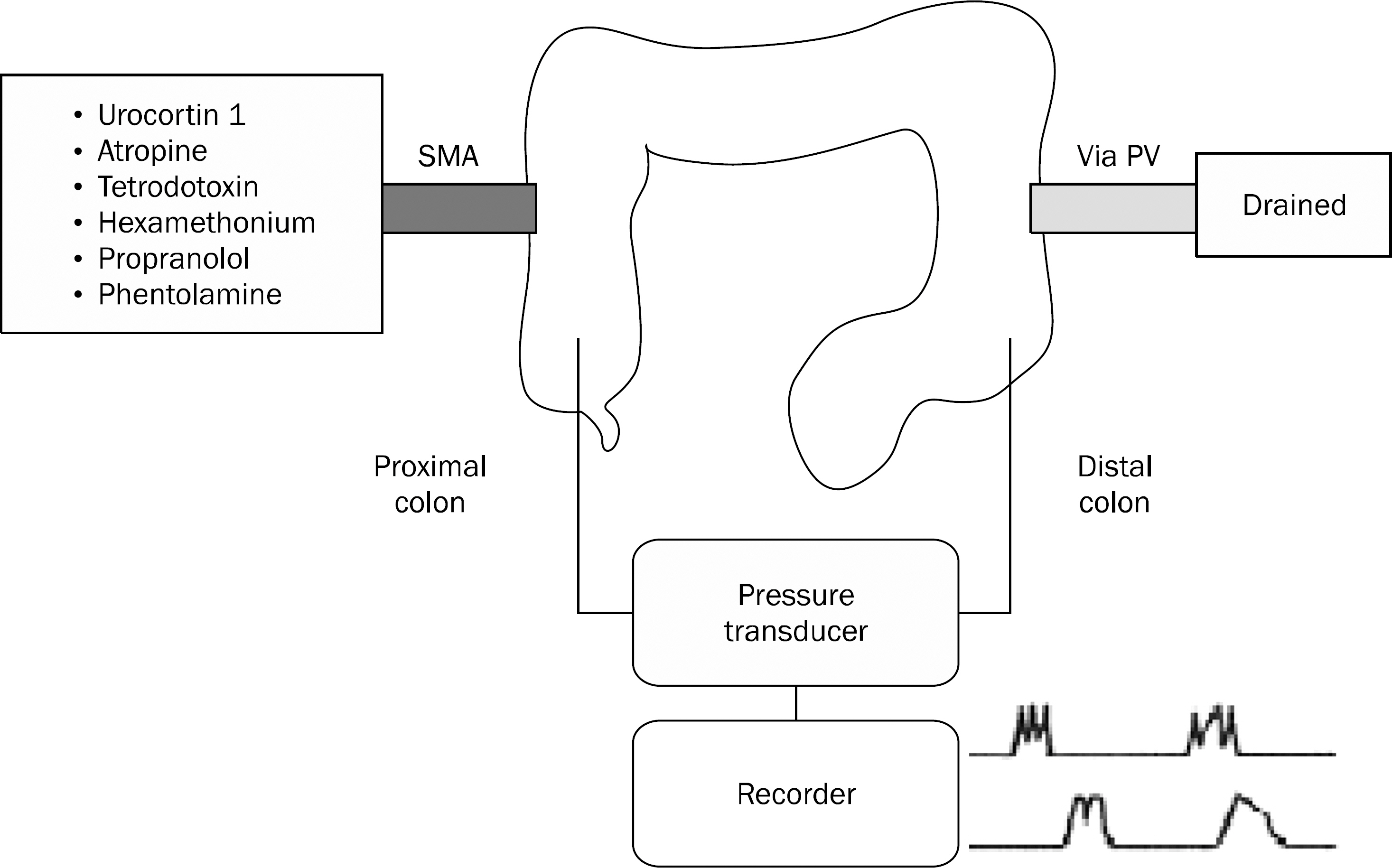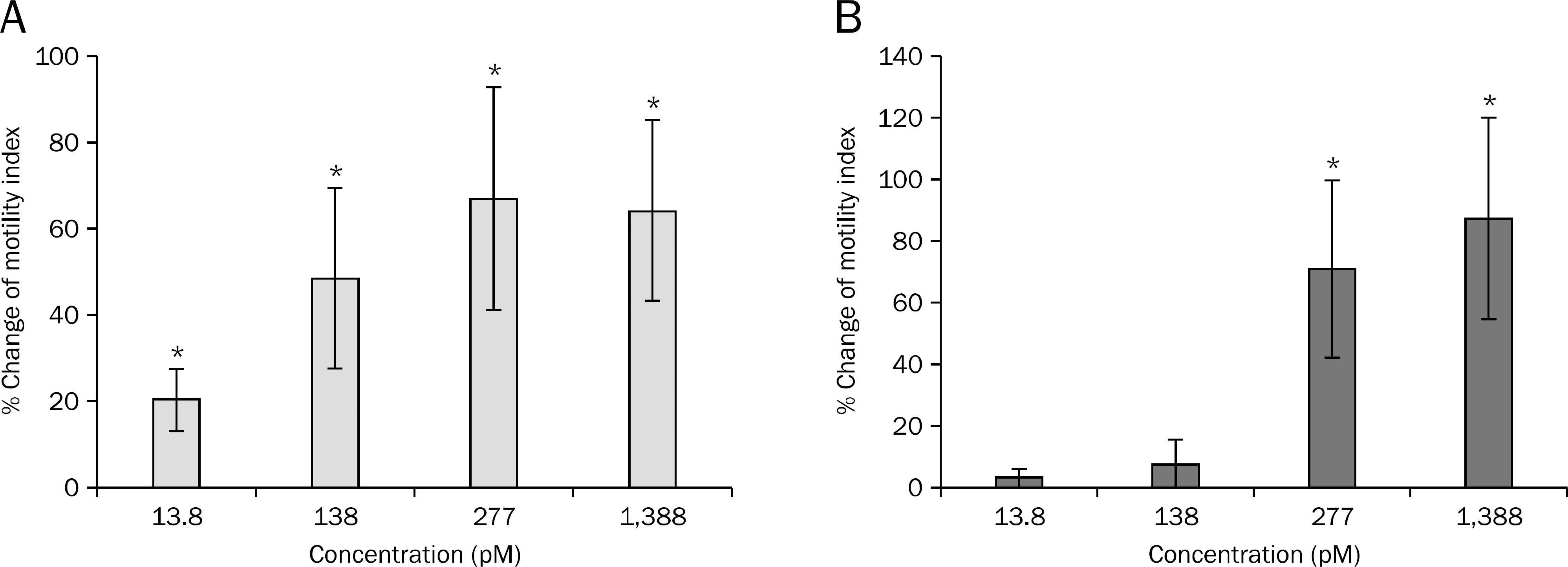Korean J Gastroenterol.
2015 May;65(5):283-290. 10.4166/kjg.2015.65.5.283.
The Effect of Urocortin 1 on Motility in Isolated, Vascularly Perfused Rat Colon
- Affiliations
-
- 1Department of Internal Medicine, Chungbuk National University College of Medicine, Cheongju, Korea. sjyoun@chungbuk.ac.kr
- KMID: 2373224
- DOI: http://doi.org/10.4166/kjg.2015.65.5.283
Abstract
- BACKGROUND/AIMS
Urocortin 1, a corticotropin-releasing factor related peptide, increases colonic motility under stressful conditions. We investigated the effect of urocortin 1 on colonic motility using an experimental model with isolated rat colon in which the blood flow and intestinal nerves were preserved. Furthermore, we assessed whether this effect was mediated by adrenergic or cholinergic nerves.
METHODS
Colonic motility was measured in the proximal and distal parts of resected rat colon. The colon resected from the peritoneum was stabilized, and then urocortin 1 (13.8, 138, 277, and 1,388 pM) was administered via a blood vessel. Motility index was measured in the last 5 min of the 15 min administration of urocortin 1 and expressed as percentage change from baseline. Subsequently, the change in motility was measured by perfusing urocortin 1 in colons pretreated with phentolamine, propranolol, hexamethonium, atropine, or tetrodotoxin.
RESULTS
At concentrations of 13.8, 138, 277, and 1,388 pM, urocortin 1 increased the motility of proximal colon (20.4+/-7.2%, 48.4+/-20.9%, 67.0+/-25.8%, and 64.2+/-20.9%, respectively) and the motility of distal colon (3.3+/-3.3%, 7.8+/-7.8%, 71.1+/-28.6%, and 87.4+/-32.5%, respectively). The motility induced by urocortin 1 was significantly decreased by atropine to 2.4+/-2.4% in proximal colon and 3.4+/-3.4% in distal colon (p<0.05). However, tetrodotoxin, propranolol, phentolamine, and hexamethonium did not inhibit motility.
CONCLUSIONS
Urocortin 1 increased colonic motility and it is considered that this effect was directly mediated by local muscarinic cholinergic receptors.
Keyword
MeSH Terms
-
Animals
Colon/*drug effects/physiology
Injections, Intravenous
Male
Muscle Contraction/drug effects
Neurotransmitter Agents/pharmacology
Rats
Rats, Sprague-Dawley
Receptors, Cholinergic/chemistry/metabolism
Urocortins/isolation & purification/*pharmacology
Neurotransmitter Agents
Receptors, Cholinergic
Urocortins
Figure
Reference
-
References
1. Bale TL, Vale WW. CRF and CRF receptors: role in stress re-sponsivity and other behaviors. Annu Rev Pharmacol Toxicol. 2004; 44:525–557.
Article2. Owens MJ, Nemeroff CB. Physiology and pharmacology of corti-cotropin-releasing factor. Pharmacol Rev. 1991; 43:425–473.3. Hauger RL, Grigoriadis DE, Dallman MF, Plotsky PM, Vale WW, Dautzenberg FM. International Union of Pharmacology. XXXVI. Current status of the nomenclature for receptors for cortico-tropin-releasing factor and their ligands. Pharmacol Rev. 2003; 55:21–26.
Article4. Weninger SC, Dunn AJ, Muglia LJ, et al. Stress-induced behaviors require the corticotropin-releasing hormone (CRH) receptor, but not CRH. Proc Natl Acad Sci USA. 1999; 96:8283–8288.
Article5. Hsu SY, Hsueh AJ. Human stresscopin and stresscopin-related peptide are selective ligands for the type 2 corticotropin-releasing hormone receptor. Nat Med. 2001; 7:605–611.
Article6. Lewis K, Li C, Perrin MH, et al. Identification of urocortin III, an additional member of the corticotropin-releasing factor (CRF) family with high affinity for the CRF2 receptor. Proc Natl Acad Sci USA. 2001; 98:7570–7575.
Article7. Donaldson CJ, Sutton SW, Perrin MH, et al. Cloning and characterization of human urocortin. Endocrinology. 1996; 137:2167–2170.
Article8. Takahashi K, Totsune K, Sone M, et al. Regional distribution of urocortin-like immunoreactivity and expression of urocortin mRNA in the human brain. Peptides. 1998; 19:643–647.
Article9. Okosi A, Brar BK, Chan M, et al. Expression and protective effects of urocortin in cardiac myocytes. Neuropeptides. 1998; 32:167–171.
Article10. Slominski A, Roloff B, Curry J, Dahiya M, Szczesniewski A, Wortsman J. The skin produces urocortin. J Clin Endocrinol Metab. 2000; 85:815–823.
Article11. Singh LK, Boucher W, Pang X, et al. Potent mast cell de-granulation and vascular permeability triggered by urocortin through activation of corticotropin-releasing hormone receptors. J Pharmacol Exp Ther. 1999; 288:1349–1356.12. Bamberger CM, Wald M, Bamberger AM, Ergün S, Beil FU, Schulte HM. Human lymphocytes produce urocortin, but not cor-ticotropin-releasing hormone. J Clin Endocrinol Metab. 1998; 83:708–711.
Article13. Chen CY, Million M, Adelson DW, Martínez V, Rivier J, Taché Y. Intracisternal urocortin inhibits vagally stimulated gastric motility in rats: role of CRF(2). Br J Pharmacol. 2002; 136:237–247.
Article14. Kihara N, Fujimura M, Yamamoto I, Itoh E, Inui A, Fujimiya M. Effects of central and peripheral urocortin on fed and fasted gas-troduodenal motor activity in conscious rats. Am J Physiol Gastrointest Liver Physiol. 2001; 280:G406–G419.
Article15. Martínez V, Taché Y. Role of CRF receptor 1 in central CRF-in-duced stimulation of colonic propulsion in rats. Brain Res. 2001; 893:29–35.16. Martínez V, Wang L, Rivier J, Grigoriadis D, Taché Y. Central CRF, urocortins and stress increase colonic transit via CRF1 receptors while activation of CRF2 receptors delays gastric transit in mice. J Physiol. 2004; 556:221–234.17. Maillot C, Million M, Wei JY, Gauthier A, Taché Y. Peripheral corti-cotropin-releasing factor and stress-stimulated colonic motor activity involve type 1 receptor in rats. Gastroenterology. 2000; 119:1569–1579.
Article18. Martínez V, Wang L, Rivier JE, Vale W, Taché Y. Differential actions of peripheral corticotropin-releasing factor (CRF), urocortin II, and urocortin III on gastric emptying and colonic transit in mice: role of CRF receptor subtypes 1 and 2. J Pharmacol Exp Ther. 2002; 301:611–617.
Article19. Kimura T, Amano T, Uehara H, et al. Urocortin I is present in the enteric nervous system and exerts an excitatory effect via cholinergic and serotonergic pathways in the rat colon. Am J Physiol Gastrointest Liver Physiol. 2007; 293:G903–G910.
Article20. Cuber JC, Vilas F, Charles N, Bernard C, Chayvialle JA. Bombesin and nutrients stimulate release of CCK through distinct pathways in the rat. Am J Physiol. 1989; 256:G989–G996.
Article21. Cuber JC, Herrmann C, Kitabgi P, et al. Neuromedin-N is not released with neurotensin from rat ileum. Endocrinology. 1990; 126:1584–1592.
Article22. Martinez V, Wang L, Million M, Rivier J, Taché Y. Urocortins and the regulation of gastrointestinal motor function and visceral pain. Peptides. 2004; 25:1733–1744.
Article23. Gourcerol G, Wu SV, Yuan PQ, et al. Activation of cortico-tropin-releasing factor receptor 2 mediates the colonic motor coping response to acute stress in rodents. Gastroenterology. 2011; 140:1586–1596.e6.
Article24. Terlau H, Heinemann SH, Stühmer W, et al. Mapping the site of block by tetrodotoxin and saxitoxin of sodium channel II. FEBS Lett. 1991; 293:93–96.
Article25. Gershon MD. Effects of tetrodotoxin on innervated smooth mus-cle preparations. Br J Pharmacol Chemother. 1967; 29:259–279.
Article26. Narahashi T. Mechanism of action of tetrodotoxin and saxitoxin on excitable membranes. Fed Proc. 1972; 31:1124–1132.27. Okuno Y, Kondo T, Saeki A, Uchida E, Teraoka H, Kitazawa T. Colon-specific contractile responses to tetrodotoxin in the isolated mouse gastrointestinal tract. Auton Autacoid Pharmacol. 2011; 31:21–30.
Article28. Kim BJ, Jones HP. Implications of corticotropin releasing factor in targeted anticancer therapy. J Pharm Pract. 2010; 23:86–90.
Article29. Paez-Pereda M, Hausch F, Holsboer F. Corticotropin releasing factor receptor antagonists for major depressive disorder. Expert Opin Investig Drugs. 2011; 20:519–535.
Article30. Lowery EG, Thiele TE. Pre-clinical evidence that corticotropin-releasing factor (CRF) receptor antagonists are promising targets for pharmacological treatment of alcoholism. CNS Neurol Disord Drug Targets. 2010; 9:77–86.
Article31. Boonprasert P, Lailerd N, Chattipakorn N. Urocortins in heart failure and ischemic heart disease. Int J Cardiol. 2008; 127:307–312.
Article32. O'Malley D, Quigley EM, Dinan TG, Cryan JF. Do interactions between stress and immune responses lead to symptom ex-acerbations in irritable bowel syndrome? Brain Behav Immun. 2011; 25:1333–1341.33. Elsenbruch S. Abdominal pain in irritable bowel syndrome: a review of putative psychological, neural and neuro-immune mechanisms. Brain Behav Immun. 2011; 25:386–394.
Article34. Lee OY. Psychosocial factors and visceral hypersensitivity in irritable bowel syndrome. Korean J Gastroenterol. 2006; 47:111–119.35. Taché Y, Martinez V, Wang L, Million M. CRF1 receptor signaling pathways are involved in stress-related alterations of colonic function and viscerosensitivity: implications for irritable bowel syndrome. Br J Pharmacol. 2004; 141:1321–1330.
Article
- Full Text Links
- Actions
-
Cited
- CITED
-
- Close
- Share
- Similar articles
-
- The Effect of Galanin on Colonic Motility in Isolated, Vascularly Perfused Rat Colon
- Mechanism of Action of Cholecystokinin on Colonic Motility in Isolated, Vascularly Perfused Rat Colon
- The Effect of Autonomic Nerve System on Neurotensin Induced Motility in Isolated, Vascularly Perfused Rat Colon
- The Mechanism of 5-Hydroxytryptamine4 (5-HT4) Receptor Partial Agonist (Tegaserod) on Rat Colonic Motility
- The Action of Substance P on the Colonic Motility in Rat Colon






